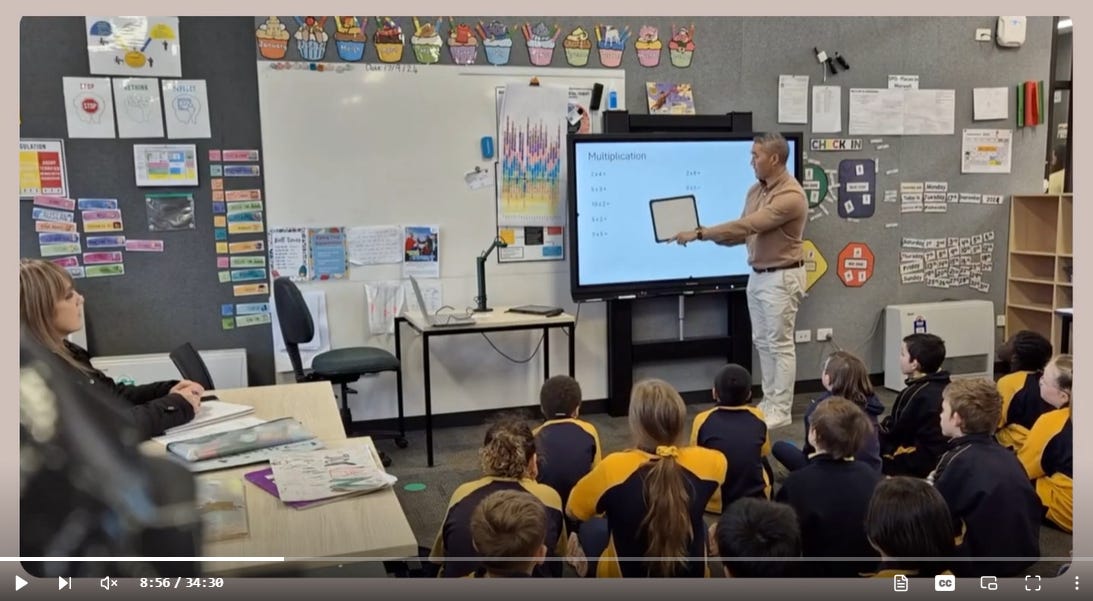Summary
In this episode of Chalk Dust, Rebecca Birch and Nathaniel Swain are joined by instructional coach and Knowledge for Teachers podcast host Brendan Lee. Together, they step inside a Year 3/4 classroom at Morwell Central Primary School, where Brendan delivers a real-time maths lesson on the commutative property of multiplication.
They unpack the anatomy of a high-impact lesson, covering how mistake analysis can build reasoning, why mini whiteboard routines make or break lesson flow, and how classroom culture can be shaped in real time, even with a class you've never met.
They explore the role of motivation, including how framing content as a “cheat code” gives students a reason to care, and why explicitly teaching mathematical vocabulary supports fluency and retention. Brendan explains how and when to fade scaffolds, the value of concrete–pictorial–abstract progressions, and how this links to dual coding and cognitive load theory.
The episode also teases apart the subtle differences between checks for listening, understanding, and thinking, and offers practical strategies for maximising participation and feedback without overcomplicating the lesson. Whether you’re a primary or secondary teacher, maths specialist or not, this episode highlights just how responsive, structured teaching can lift engagement and understanding.
Mentioned resources and explainers
Ochre Education
Brendan is a board member at Ochre, which provides free, evidence-informed teaching resources, including primary Mathematics, for Australian classrooms.
The Knowledge for Teachers podcast
Hosted by Brendan Lee, this show features deep-dive conversations with leading educators.
Concrete–Pictorial–Abstract (CPA) Framework
A core maths instructional sequence. Brendan explains how his dot arrays and number lines support cognitive development by moving students gradually toward symbolic understanding.
Fading Scaffolds
Also called the guidance fading effect. Brendan shows how support is gradually withdrawn during guided practice so students experience successful independence.
Checks for Listening
Used to keep students focused and accountable, especially during teacher modelling. Brendan uses multiple checks to ensure students stay engaged during new learning. You can learn more from Craig Barton here.
Listen or view, and support our work
📨 Substack — sign up
🍏🎧 Apple Podcasts — like, review and follow
🎵💚 Spotify — follow and rate
📺🔔 YouTube — subscribe and like
✍️ Rebecca’s Substack — read more
✍️ Nathaniel’s Substack — read more
Takeaways
Clear routines build student confidence and help new teachers take control quickly.
Mini whiteboards are powerful, but only with tight behavioural expectations.
Mistake/error analysis is a gateway to mathematical reasoning.
Varying example formats increases transfer and reduces rote pattern-matching.
Even in a scripted model, responsiveness matters—especially in guided practice.
Motivation is built when students see the value in what they’re learning.
Vocabulary in maths should be taught explicitly—just like in English.
The best learning often happens in the “we do” phase, not the “I do” or “you do”.
Keywords
primary maths, Brendan Lee, explicit teaching, guided practice, mini whiteboards, commutative property, mistake analysis, worked examples, teacher routines, classroom management, CPA framework, dual coding, cognitive load, instructional coaching, adaptive teaching, formative assessment, motivation, vocabulary in maths, checks for listening, effective modelling







